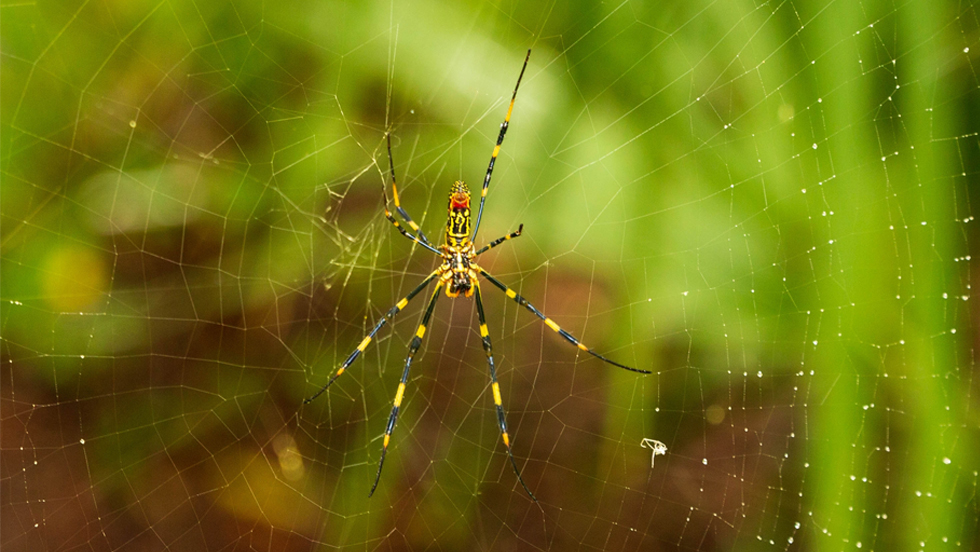
A biologist and a psychologist give us the facts about the spider and arachnophobia.
Be prepared for an uninvited guest to visit this summer. Whether you find this news welcoming or frightening depends on how you feel about … spiders.
The Joro spider, a species native to East Asia that can grow up to eight inches long, is already in the United States and is making its way to the Northeast.
If you’re interested in arachnids, the Joro’s impending arrival is something to be excited about. But if you’re one of the many people who fear even itsy-bitsy spiders, you’re probably freaking out at the thought of running into one.
Joro Facts From an Adelphi Expert
The media is sounding the alarm about how we’ll be invaded by giant, flying spiders. But this isn’t necessarily true.
The Joro is big, as mentioned earlier, but “giant” is pushing the envelope. The species isn’t the size of fictional spiders like Shelob (The Lord of the Rings) or Aragog (Harry Potter and the Chamber of Secrets). It doesn’t actually fly but moves through the air on silk threads that catch air currents. (Joros can also hitch rides on vehicles.) And we won’t be getting an Arachnophobia-worthy amount of them by any means.
Perhaps most reassuring of all, the species, according to experts, is not harmful to humans and is not out to get us.
Matthias Foellmer, PhD, is Adelphi’s “Spider-Man,” so to speak—a professor of biology who is “fascinated by spiders,” as he notes on his website.
He explained that while the Joro is non-native, “it does not appear to be invasive, but rather is in the process of becoming naturalized. Orb-weaving spiders rarely, if ever, compete over food and are typically not abundant enough to threaten prey species.”
That means, unlike our recent nemeses, the lanternfly and the brown marmorated stink bug, the Joro is not expected to have a negative impact on native organisms. And while we were told to kill invasive insects on sight, there’s no call to do the same to Joros. In fact, Dr. Foellmer suggests we view the Joro as our ally in the bug battle. “If anything, it’ll catch at least some of the bugs you don’t like, like lanternflies and mosquitoes,” he said.
If you see a Joro outside, leave it alone, he advised. What if one comes inside? “I’d be surprised if one would ever come into your house, but should you encounter one inside, gently push it into a jar and release it outside,” he said.
He added, “They are beautiful! View it like a pretty flower.”
Tips for Joro Phobia From an Adelphi Expert
If you’re still not swayed, you’re not alone. Joel Weinberger, PhD, a clinical and research psychologist and professor at the Adelphi University Gordon F. Derner School of Psychology, has studied phobias and the unconscious mind for about 20 years and has published on the subjects.
“A phobia is an intense, irrational fear of an object or type of experience that is disproportionate to the actual danger posed and can cause significant distress and impairment in daily functioning,” he said, adding that arachnophobia—fear of spiders—is one of the top 10 phobias people experience, and, “Most people are uncomfortable around spiders even if they don’t have a full-blown phobia.”
Arachnophobia isn’t entirely irrational; there is a biological/evolutionary component, he explained. Since some species of spiders can be harmful to humans, our ancestors who avoided all species were more likely to survive than those who took a chance and did not.
If you encounter a Joro and have a phobia, “you will freak out,” he said. He advised that if the phobia affects your daily life—for example, you’re afraid to go outside for fear of running into a spider—psychological treatment can help. Exposure therapy is the most effective. As it sounds, the patient is gradually and systematically exposed to the feared object—real, virtual or an image—in a controlled and safe environment, thereby helping you confront and reduce your fear and anxiety over time.
A Matter of Perspective
In Charlotte’s Web, after Wilbur the pig first meets Charlotte A. Cavatica, the spider who would save his life, he asks himself: “Charlotte is fierce, brutal, scheming, bloodthirsty—everything I don’t like. How can I learn to like her, even though she is pretty and, of course, clever?”
If you’re asking yourself the same question, consider the benefits of spiders to our ecosystem. As Charlotte says, “…do you realize that if I didn’t catch bugs and eat them, bugs would increase and multiply and get so numerous that they’d destroy the earth, wipe out everything?”
Or as Billie Eilish, who worked with live tarantulas in her “You Should See Me in a Crown” vertical video and has one for a pet, said (as reported in Variety), “They’re fun. They’re not gonna hurt you. They’re cool.”